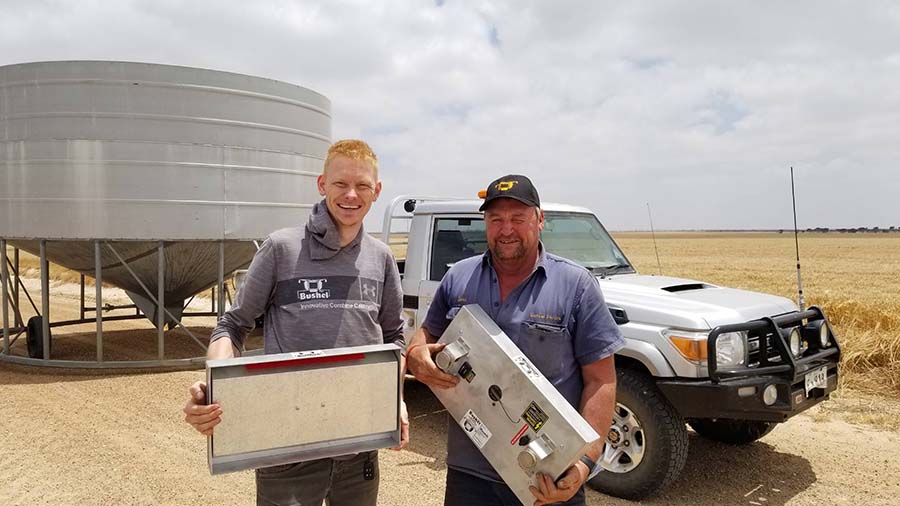New equipment is helping grain growers calculate, measure and manage harvest losses.
Australian growers are leaving hundreds of thousands of tonnes of their canola crops on the ground, with some individual losses estimated at about 15 per cent of total crop yields.
Measuring these losses, followed by making simple changes to the set-up of your harvester, could add thousands of dollars to your harvest profits every year, according to Planfarm's Peter Newman.
Mr Newman has been trialling equipment including drop trays with growers across Western Australia's wheatbelt to measure, and help growers manage, these losses.
He believes growers have been grossly underestimating their grain losses, particularly when it comes to their canola crops.
"Tiny canola seeds are very difficult to see either on the paddock floor, or in among the windrows, so unless you have a formal measuring system in place, you can't really tell what your losses actually are," Mr Newman says.
"Cereals are also hard to measure simply by looking at the losses in the paddock, but canola is particularly difficult because of the size of the seed - it's like trying to find a needle in a haystack."
Mr Newman says some farmers are losing up to 400 kilograms per hectare of seed from the back of their header, which could be a significant percentage of their profit, or all of their profit, from that crop.
"This is a real example of what we have seen out in the paddocks when we are trialling drop trays, and it's not an isolated story," he says.
"In my experience, growers are underestimating how much they are really losing out the back of their headers."
He says canola losses could be costing the WA industry as much as $90 million annually, equating to an average of $75/ha.
In my experience, growers are underestimating how much they are really losing out the back of their headers
- Planfarm consultant Peter Newman
Drop trays
A number of different brands of drop trays are now available, including the Bushel Plus Multi Calibration System and the ScherGain Solution System.
The trays fix on to the underside of the harvester with electromagnets and can be dropped on to the ground while the harvester is moving using a remote control.
The material in the tray is put through a sieve, and the sieved grain is then weighed and measured to determine loss percentages.

Marcel Kringe from Bushel and Daren Curnow from Darkel Farms, Esperance, with drop tray equipment. Photo Peter Newman
Mr Newman says some growers have engineered their own drop trays, which can be used in conjunction with his Harvest Loss Calculator, which is now available on the GRDC website.
He says there is no simple recipe to set up all harvesters to minimise losses - but a trial-and-error approach, changing one thing at a time, is the best way forward.
As part of the GRDC-invested project, Mr Newman circulated several different brands of drop trays around WA's wheatbelt during the 2018 harvest, with growers reporting their findings on a Twitter feed at @harvestloss
Mr Newman says the results have been surprising.
"One grower who borrowed the drop tray first tested his losses at 280kg/ha, and by simply changing his fan set-up he was able to reduce his losses down to 72kg/ha - putting $58,000 back into his pocket by the end of harvest," he says.
"As an industry, we believe a one per cent cereal loss, and three per cent canola loss, is acceptable.
"Anything more than that and your harvester set up may not be right.
"In the future it would be great to achieve less than 3 per cent loss for canola."
Sometimes it's also about finding what Mr Newman terms as "the economic sweet spot" between the speed of harvest and grain losses.
"It may not just be about achieving the lowest possible grain loss, but also ensuring the lowest possible cost of harvest," he says.
"If you have to slow right down to get the losses at the lowest rates possible, you may end up doubling the cost of the harvest, so it's about finding that sweet spot where you have acceptable losses and good harvest efficiency."
The message
The simple message to growers is to measure losses every day, or even twice a day, during harvest and change one thing at a time until losses are at acceptable levels.
"If you don't measure it, you can't manage it," Mr Newman says.
While it can be a messy job to measure grain losses, the new commercially available drop trays are easy to use and relatively cheap in comparison to the value of crop losses.
"Some loss measuring systems come with a fan-driven separator, making twice daily measurements more realistic."
But measuring these losses at the start of harvest isn't enough, Mr Newman warns, given crop maturity changes throughout the harvest months.
"Canola crops will be greener at the start of harvest, and the losses will be significantly less as a result," he says.
"As you progress through harvest and the crop dries out, these losses will increase, which is why it's important to continually measure, monitor and manage the situation right through the harvest period."
More information: Peter Newman, 0427 984 010, Harvest Loss Calculator

























































